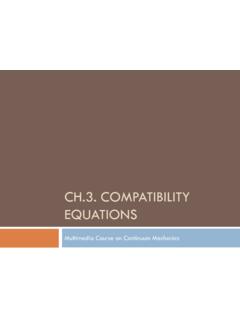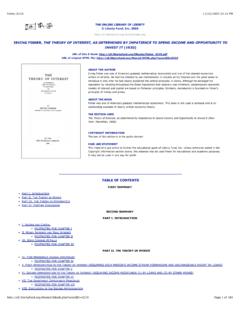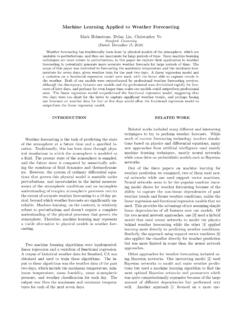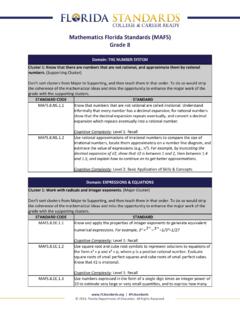Transcription of Coastal Regulation in India
1 Coastal Regulation in India Why Do We Need a New Notification? Coastal Regulation in India Why Do We Need a New Notification? Coastal Regulation in India Why Do We Need a New Notification? Published in India , 2008 by equations . This publication may be reproduced in whole or in part for educational, advocacy or not-for- profit purposes. We would appreciate acknowledging us as the source and letting us know of the use. Citation: equations (2008) Coastal Regulation in India Why Do We Need a New Notification? , equations , Bangalore. equations (Equitable Tourism Options). # 415, 2-C Cross 4th Main, OMBR Layout Banaswadi Bangalore 560 043. India Ph: +91-80-25457607/25457659. Fax: +91-80-25457665. Email: Website: Layout & Printing: Focus Communications, Bangalore Photograph on cover: Peerless Resort, Corbyn's Cove, Port Blair, Andaman & Nicobar Islands (by equations ). ii Table of contents Preface .. 1. Part I: Coastal Regulation Zone Notification, 1991.
2 3. Part II: Swaminathan Committee Report, 2005 .. 15. Part III: Draft Coastal Management Zone Notification, 2008 .. 22. Part IV: The Way Forward .. 31. References .. 33. Annexures Annexure 1: equations Analysis of the CRZ Notification, 1991 .. 35. Annexure 2: Chronology of amendments to the CRZ Notification .. 40. Annexure 3: equations Analysis of the M S Swaminathan Committee (MSSC). Report Recommendations, 2005 .. 48. Annexure 4: equations Analysis of the proposed CMZ Notification, 2008 .. 56. Annexure 5: Various committees constituted by MoEF on CRZ .. 59. iii Coastal Regulation in India Why Do We Need a New Notification? equations . Preface In the context of this move by the MoEF, an analysis The proposal of the Ministry of Environment and of the CRZ Notification, 1991, the Swaminathan Forests (MoEF) to replace the Coastal Regulation Committee recommendations and the draft CMZ. Zone Notification (CRZ), 1991 with a Coastal Notification has been made in order to substantiate Management Zone Notification (CMZ) after the the position to continue and strengthen the current review of implementation of CRZ by the Swaminathan Regulation in the form of CRZ rather than substitute it Committee has evoked strong opposition from with another.
3 In this regard, a detailed comparison various stakeholders, especially the Coastal has been made to arrive at recommendations. The communities. Fisher folk associations and argument is further validated by taking the example organisations like the National Fishworkers Forum, of tourism as a development phenomenon that has Coastal Action Network, Indian Coastal Women affected the coast; hence the need to have stringent Movement, National Union of Fishermen, South India regulatory norms to curb adverse impacts on Fishermen Welfare Association, Tamilnadu communities and ecosystems. Fishermen Welfare Association, Tamil Nadu Pondy Fisher People Federation, Democratic Unorganised This document is divided into four parts: the first part Workers Trade Union, Fish Marketers Association of analyses the CRZ Notification, 1991 and issues of Tamil Nadu and Kerala Swatantra Matsya Thozhilali its implementation. It further looks at violations of Federation have vehemently opposed the proposal the CRZ Notification, 1991 by tourism.
4 The second and have made submissions to the MoEF to withdraw part is an evaluation of the Swaminathan Committee the proposal. The Swaminathan Committee report recommendations. The third section is a critique of has also been critiqued by civil society organisations the draft CMZ Notification 2008. Finally it has been working on Coastal ecology and with communities. suggested that the current CRZ Notification needs to Despite the efforts to persuade the MoEF in not be strengthened and rigorously implemented rather bringing out the CMZ Notification, the MoEF issued a than replace it with a feeble and ambiguous CMZ. draft in May 2008 proposing to phase out the CRZ Notification in the section on The Way Forward. Notification and implement the CMZ Notification. 1. Part I. Coastal Regulation Zone Notification, 1991. The Indian Coastal stretch of about 7,500 km is ! If Coastal ecosystems are sustainably managed, made up of diverse ecosystems - sand dunes, then the livelihoods of millions will be protected beaches, wetlands, mangroves, estuaries, and their survival guaranteed.
5 Backwater lagoons and coral reefs. Settlements of traditional people comprising about 10 million The CRZ Notification, 1991 covers the strip of fisherfolk, are concentrated in these areas, as they Coastal land abutting the sea all along India 's coast mainly depend on Coastal resources and seas for and her islands. It extends 500 metres from the High their survival. Several activities such as unregulated Tide Line (HTL). In this narrow sensitive region, tourism, polluting industries, infrastructure, cer tain activities are regulated while other aquaculture, sand mining, construction of sea walls inappropriate ones are prohibited. The CRZ. and rapid urbanization pose serious threats to the notification seeks to operationalise three objectives, health of these ecosystems and to the lives and which are very significant: livelihoods of Coastal communities. The tsunami of 2004 has shown that the coast is a naturally vulnerable area and that these activities have 1.
6 Siting or location of activities or operations worsened the impacts on Coastal people. This is based on the understanding that coasts per for m impor tant functions for Coastal The Coastal Regulation Zone Notification, issued in communities and ecosystems. The coasts are 1991 using the provisions of the Environment important nesting and feeding grounds for several (Protection) Act, 1986 is the most significant and terrestrial and aquatic species. These Coastal specialized legislation regulating developmental habitats also provide sustenance and livelihood activities along the coast. It recognized India 's need opportunities to several Coastal communities (both to protect the interests of millions of her Coastal fishing and non-fishing communities). Rules for the people while ensuring their overall development, and siting of activities can ensure that the rights of protecting Coastal ecology. traditional fishing and Coastal communities over certain areas are not compromised to meet The CRZ Notification was introduced with three main increasing development requirements such as the principles: demands of the burgeoning tourism industry.
7 ! It is necessary to arrive at a balance between development needs and protection of natural 2. Restricting and permitting activities resources;. The CRZ Notification defines the nature of activities ! Certain activities are harmful for both Coastal that are to be regulated or restricted. It does not communities and their environment, and these issue a blanket ban on all activities but lists activities should be prohibited or regulated; that are restricted and those that are permitted. 3. Coastal Regulation in India Why Do We Need a New Notification? 3. Balancing development and protection categorically identifying the CRZ area and therefore identifying a violation has become needs difficult. This objective is ingrained in the spirit of the CRZ, which recognises that different areas have different ! No progress on development of Coastal Zone ecological sensitivities and therefore need varying Management Plans levels or modes of protection.
8 Thus, the protection afforded to CRZ I is designed to be more stringent Not a single Coastal state or union territory has a than that accorded to CRZ II areas, where more fully approved Coastal Zone Management Plan activities are permitted. (CZMP). This document is critical to the implementation of the law as it identifies the With respect to Andaman & Nicobar Islands and various CRZ areas and therefore the range of Lakshadweep, the CRZ would be instrumental in activities that can be permitted or prohibited. deciding activities and developments because of Without this in place, unregulated activities and their special status as oceanic island groups developments are common on the coast. After recognized by CRZ as Category IV. Moreover, the CRZ Notification, 1991 was issued; all the environmental issues confronting these islands are states were instructed to prepare and submit the more complex; it is critically important to address CZMP within one year, by February 1992 to these.
9 For a detailed analysis of the CRZ Notification, the MoEF for final approval. No states or UTs 1991, refer annexure 1. submitted the CZMP and the Supreme Court had to intervene thereby extending the date of submitting the CZMP to June 1996. All the states What went wrong with the implementation of the and UTs submitted their CZMPs in 1996, after Notification? which the MoEF reviewed them and wrote back to The implementation of this critical Notification was the states and UTs. The states and UTs were by and large ignored by many state governments. given comments on their respective CZMPs, Vested interests from various lobbies such as the which they had to incorporate, and in some cases tourism and industrial lobby have constantly sought rework maps, and re-submit to the MoEF for final to get rid of this Notification. The CRZ Notification approval. After this, it is not known which states has been amended twenty one times between 1994 have resubmitted their CZMP for final approvals and 2005, and each dilution has weakened from the MoEF and whether the MoEF has provisions of the law.
10 A detailed chronology of various approved any one of them. Neither did the amendments is given in annexure 2. concerned authorities inform concerned stakeholders on the finalisation of the CZMPs ! Non-Demarcation of High Tide Line and nor have the stakeholders been able to elicit a response from the concerned authorities on the 1122(E) dated 29th December 19981 only status of CZMPs. Therefore, it is given to surmise gave the definition of the HTL and stated that it that no Coastal state or UT has a functional, will be marked by an authority. It is surprising that approved CZMP. 7 years after the Notification was issued, the central government did not specify which authority Implications of amendments made to the CRZ. and did not provide guidelines for marking the Notification, 1991. HTL. Further, the High Tide Line (HTL) or the 500m / 200m line from the HTL has not been ! Construction for petroleum storage to be allowed in demarcated in any Coastal states, although CRZ II & III.





